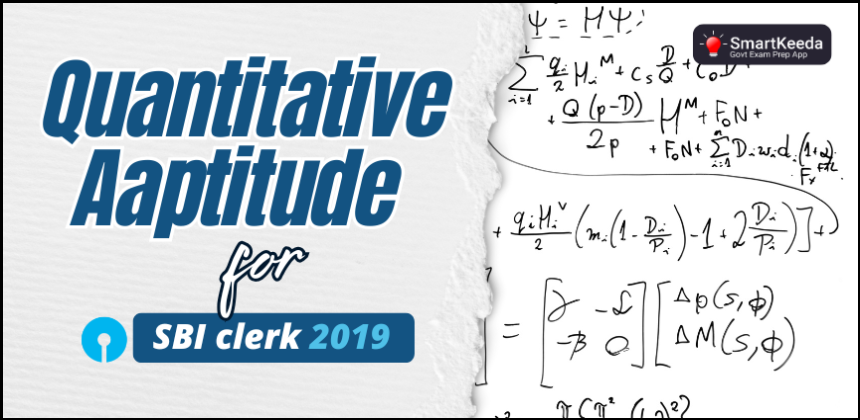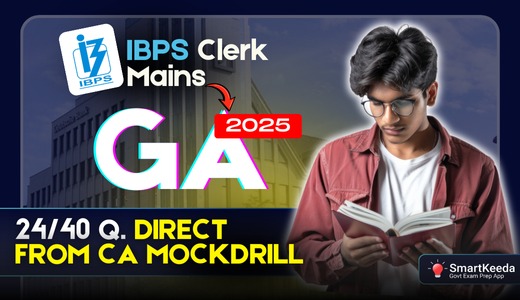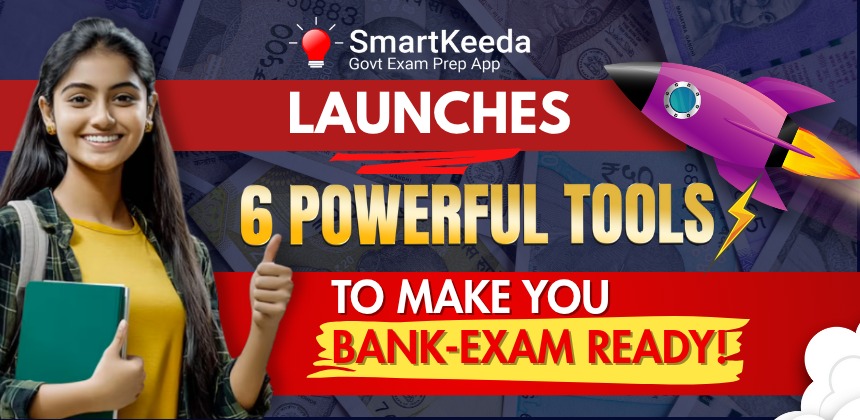Quantitative Aptitude Questions with Answers for SBI Clerk 2019 | How to Prepare Quantitative Aptitude for SBI Clerk Exam

Hello Guys,
As you all know SBI Clerk 2019 notification has been announced and everyone wants to be a part of India’s most prestigious bank job at any cost, so it is time to show your aptitude knowledge and join SBI (State Bank of India) as Clerk.
If you are really interested to be a part of SBI as a Clerk, you have to crack two phases exam, first one Prelims and the second one is Mains.
Those aspirants who qualified prelims they will appear in SBI Clerk Mains. In SBI Clerk Prelims it’s consist of 3 sections Quantitative Aptitude, Reasoning Aptitude and English Language.

Quantitative Aptitude for SBI Clerk 2019, it’s a compulsory section. You can’t avoid. So make sure you have already good at basics of Quantitative Aptitude, here we discuss all the seven types questions they have a high chance to appear in your Quantitative Aptitude section of SBI Clerk Prelims 2019. As you all know Quantitative Aptitude section or Numerical Ability requires more and more practice so you need to start it as soon as possible because we have not much time for an exam.
Here are all Quantitative Questions for SBI Clerk Prelims 2019 :
1. Number Series
In Number Series Questions for SBI Clerk Prelims, five questions generally asked with different patterns of Number Series. Aspirants hardly take three to four minutes to solve these questions.
Basically there are two types of Number Series, first is Missing term number series and the second one is the Wrong term, in missing term series we have to find the next term.
Here are some patterns which have been seen in SBI Clerk Prelims exams:
(I). 43 69 58 84 73 ?
(A.) 63
(B.) None of these
(C.) 98
(D.) 62
(E.) 109
Explanation:
Series Pattern |
Given Series |
|
|
43 |
43 |
|
|
43 + 26 = 69 |
69 |
|
|
69 – 11 = 58 |
58 |
|
|
58 + 26 = 84 |
84 |
|
|
84 – 11 = 73 |
73 |
|
|
73 + 26 = 99 |
99 |
✓ |
Hence, option B is correct.
(II). 22 28 46 76 118 ?
(A.) 183
(B.) 172
(C.) None of these
(D.) 177
(E.) 169
Explanation:
Series Pattern |
Given Series |
|
|
22 |
22 |
|
|
22 + (6 × 1) = 28 |
28 |
|
|
28 +(6 × 3) = 46 |
46 |
|
|
46 +(6 × 5) = 76 |
76 |
|
|
76 +(6 × 7) = 118 |
118 |
|
|
118 +(6 × 9) = 172 |
172 |
✓ |
Hence, option B is correct.
(III). 16 20 84 120 632 ?
(A.) 712
(B.) 693
(C.) 683
(D.) None of these
(E.) 731
Explanation:
|
Series Pattern |
Given Series |
|
|
16 |
16 |
|
|
16 + 22 = 20 |
20 |
|
|
20 + 43 = 84 |
84 |
|
|
84 + 62 = 120 |
120 |
|
|
120 + 83 = 632 |
632 |
|
|
632 + 102 = 732 |
732 |
✓ |
Hence, option D is correct.
(IV). 22 37 142 457 ? 2437
(A.) 1112
(B.) 1213
(C.) 1150
(D.) 1214
(E.) None of these
Explanation:
|
Series Pattern |
Given Series |
|
|
22 |
22 |
|
|
22 + 15 (1×3×5) = 37 |
37 |
|
|
37 + 105 (3×5×7) = 142 |
142 |
|
|
142 + 315 (5×7×9) = 457 |
457 |
|
|
457 + 693 (7×9×11) = 1150 |
1150 |
✓ |
|
1150 + 1287 (9×11×13) = 2437 |
2437 |
|
Hence, option C is correct.
2. Data Interpretation
DI Questions for SBI Clerk 2019, here you will also see 5 to 10 questions have been seen in previous year’s papers.
Data Interpretation Questions are generally are in the form of Bar Chart, Table Chart, Pie Chart, and caselet DI etc. You can easily score good marks if you are good at simplification or basic arithmetical expressions.
Here is a example of Data Interpretation for SBI Clerk 2019.
The following table gives the information about the number of marks obtained by five students in five subjects in an examination (the total marks in every subject are 300 each)
|
Subjects |
|||||
|
Student |
English |
Maths |
Physics |
Biology |
Hindi |
|
A |
180 |
290 |
215 |
190 |
192 |
|
B |
210 |
230 |
264 |
228 |
102 |
|
C |
285 |
175 |
176 |
186 |
132 |
|
D |
185 |
165 |
188 |
136 |
144 |
|
E |
225 |
230 |
162 |
98 |
156 |
(I). The total marks obtained by D and E together in Biology and Hindi together was approximately what percent of the marks obtained by A alone in Maths?
(A.) 187.32%
(B.) 192.21%
(C.) 181.24%
(D.) 184.14%
(E.) 179.32%
Explanation:
The total marks obtained by D and E together in Biology and Hindi together = 136 + 98 + 144 + 156 = 534
The total marks obtained by A alone in maths = 290
Reqd. % = 534/290 × 100= 184.14% approximately
Hence, option D is correct.
(II). If the minimum passing marks of any subject was 30% of the total marks of all the subjects together then the marks obtained by B in all the subjects together was how much more than the minimum passing marks of all the subjects together?
(A.) 584
(B.) 534
(C.) 564
(D.) 575
(E.) None of the above
Explanation:
Total number of subjects = 5
The total marks of all the five subjects = 300 × 5 = 1500
Minimum passing marks = 30% of 1500 = 450
The marks obtained by B in all the subject together = (210 + 230 + 264 + 228 + 102) = 1034
The required difference = 1034 – 450 = 584
Hence, option A is correct.
(III). What was the highest total percentage of the marks of all the subjects together secured by any of the given students? (approximately)
(A.) 56.64%
(B.) 68.93%
(C.) 71.13%
(D.) 58.34%
(E.) 73.23%
Explanation:
The marks obtained by A = 1067
The marks obtained by B = 1034
The marks obtained by C = 954
The marks obtained by D = 818
The marks obtained by E = 871
Since A got the highest marks so the percentage of the marks of all the subject together will be highest for A
Reqd. % = 1067/1500 × 100 = 71.13% approximately
Hence, option C is correct.
(IV). Find the difference between the marks obtained by A and B in all the subjects together and the marks obtained by C and D in all the subjects together?
(A.) 349
(B.) 347
(C.) 345
(D.) 419
(E.) None of the above
Explanation:
The marks obtained by A and B in all the subjects together = 1067 + 1034 = 2101
The marks obtained by C and D in all the subjects together = 954 + 818 = 1772
The required difference = 2101 – 1772 = 329
Hence, option E is correct.
(V). The marks obtained in English by all the students together is approximately what percent of the marks obtained in Maths by all the students together?
(A.) 99.13%
(B.) 99.17%
(C.) 99.34%
(D.) 99.54%
(E.) 99.43%
Explanation:
The marks obtained in English by all the students together = 1085
The marks obtained in Maths by all the students together = 1090
Reqd. % = 1085/1090 × 100 = 99.54%
Hence, option D is correct.
3. Arithmetic Miscellaneous Questions
In Arithmetic Miscellaneous Questions for SBI Clerk 2019, means you will get different types of math word problems like Time & Work, Profit & Loss, Average, Mixture & Alligation, SI & CI, Time & Distance Etc. Frequently, ten to twelve questions have been seen in all bank clerk exams and the level of questions are easy to moderate. As you can see below:
(I). Ghanshyam splits his income into expenditure and savings. The ratio of his expenditure to savings is 3 : 2. If his income increases by 10% and expenditure also increases by 12% then by what percentage do his savings increase?
(A.) 4%
(B.) 5%
(C.) 7%
(D.) 10%
(E.) None of these
Explanation:
Let the total income be 100.
Then, expenditure = 60 and savings = 40
New income after an increase of 10% = 110% of 100 = 110
New expenditure after an increase of 12% = 112% of 60 = 67.2
New savings = 110 – 67.2 = 42.8
Percentage change in savings = (42.8 – 40)/40 × 100 = 7%
Hence, option C is correct.
(II). A cistern can be emptied by three pipes in 3 hours. The first can empty it in 6 hours while the second can empty it in 9 hours. How long would the third pipe alone take to empty the cistern?
(A.) 18 hours
(B.) 20 hours
(C.) 15 hours
(D.) 22 hours
(E.) None of these
Explanation:
Let the three pipes be x, y and z respectively.
Together they empty the cistern in 3 hours,
So, the part of the cistern empty in 1 hour together (x + y + z) = 1/3
And, pipe x can empty the part of the cistern in 1 hour = 1/6
And, pipe y can empty the part of the cistern in 1 hour = 1/9
Now, pipe z alone can empty the cistern in 1 hour = 1/3 – 1/6 – 1/9
= 6 – 3 – 2/18 = 1/18
Hence, pipe z can alone empty the cistern in 18 hours.
Hence, option A is correct.
(III). Pratibha bought toys at a certain rate but ended up paying for 53 toys instead of 35. If she lost Rs. 720 in this transaction, what was the amount (in Rs.) that she paid?
(A.) 2180
(B.) 2060
(C.) 2120
(D.) 2750
(E.) None of these
Explanation:
Let the rate per toy be Rs. x.
∴ Amount to be paid = Rs. (35x) and amount actually paid = Rs. (53x)
Since loss = 720, 53x – 35x = 720
∴ 18x = 720 i.e. x = 40
∴ Amount paid by Pratibha = 53 × 40 = Rs. 2,120
Hence, option C is correct.
(IV). Heeralal invests some amount every year. The annual interest rate earned on his investment gets increased by 10%. If the yearly interest rate earned on his investment this year was 11%, what was the yearly rate of interest previous year?
(A.) 1%
(B.) 1.1%
(C.) 10.8%
(D.) 10%
(E.) None of these
Explanation:
If x is the annual interest rate last year, then the annual interest rate this year is 10% greater than x, or 1.1x. It is given that 1.1x = 11%
Therefore, x = 11%/1.1 = 10%
(Note that if the given information had been that the investment increased by 10% points, then the equation would have been x + 10% = 11%)
Hence, option D is correct.
(V). The average age of 12 players in a cricket team is the same as it was 18 months ago because an old player has been replaced by a young player now. Find the difference in the age of the older and the younger player.
(A.) 21.6
(B.) 24
(C.) 18
(D.) 12
(E.) None of these
Explanation:
18 months = 1.5 years
Let the sum of the ages of the 12 players, 1.5 years back, be 12x.
∴The sum of their ages now (had the old player still been in the team) would have been 12x + (12 × 1.5) = 12x + 18
However, the sum of the ages now = sum of the ages 18 months back = 12x
∴ (Sum of the ages with the old player still in the team) - (Sum of the ages with the new player in the team ) = difference between the age of the two players = 12x + 18 – 12x = 18
Hence, option C is correct.
4. Simplification or Approximations
Simplification or Approximation questions plays major role to score high in bank clerk exams and you don’t need to be must good at maths while solving these questions,
You need to do one thing just aware with BODMAS rule, all the Simplification and Approximation Questions are very easy to solve in less time. Here are the some examples:
Approximations Questions:
I. 29.97% of 549.98 ÷ 15.05 = 39.12 – ?
(A.) 40
(B.) 15
(C.) 25
(D.) 39
(E.) 28
Explanation:
29.97% of 549.98 ÷ 15.05 = 39.12 – ?
= 30% of 550 ÷ 15 ≈ 39 – ?
= 30 × 550 ÷ 100 × 1 ÷ 15 ≈ 39 – ?
= 11 ≈ 39 – ?
= ? ≈ 39 – 11 = 28
Hence, option E is correct.
II. 3/10 of 111 = ? ÷ (1.8 × 0.499)
(A.) 100
(B.) 10
(C.) 3
(D.) 30
(E.) 60
Explanation:
3/10 of 111 = ? ÷ (1.8 × 0.499)
≈ 3/10 × 110 = ? ÷ (2 × 0.5)
≈ 3 × 11 = ? ÷ 1
? = 33 ≈ 30.
Hence, option D is correct.
III. 6499 + 3601 × 14.989 – 8789.9 = ?
(A.) 51700
(B.) 50000
(C.) 48000
(D.) 41700
(E.) 52300
Explanation:
6499 + 3601 × 14.989 – 8789.9 = ?
≈ 6500 + 3600 × 15 – 8800
= 6500 + 54000 – 8800
= 60500 – 8800 = 51700
Hence, option A is correct.
Simplification Questions:
(I). 468 ÷ 39 × 20 + 226 = ? + 420
(A.) 36
(B.) 46
(C.) 26
(D.) 16
(E.) None of these
Explanation:
468 ÷ 39 × 20 + 226 = ? + 420
? = 468 ÷ 39 × 20 + 226 – 420
= 12 × 20 + 226 – 420
= 240 + 226 – 420
? = 46
Hence, option B is correct.
(II). 42% of 580 + 3/7 of 2030 – 37% of 670 = ?
(A.) 882.7
(B.) 865.7
(C.) 872.7
(D.) 868.7
(E.) None of these
Explanation:
42% of 580 + 3/7 of 2030 – 37% of 670 = ?
? = 243.6 + 870 – 247.9
? = 865.7
Hence, option B is correct.
5. Quadratic Equation
Quadratic Equations for SBI Clerk 2019, these type questions are generally based on an arithmetic quadratic equation or you can say a polynomial is formed by adding/subtracting multiple monomials and it’s two types one which contains two terms called binomial expression and other which contains three terms is called trinomial expression.
New Pattern Quadratic Equation Quizzes for SBI Clerk 2019 Click Here
6. Data Sufficiency
Data Sufficiency Questions for SBI Clerk 2019, these kinds of problems involve testing your quantitative aptitude concepts. They normally ask the form of a logical puzzle.
Instead of solving a Data Sufficiency problem, all you need to do is determine if the given information is enough to solve the problem.
These kinds of questions also can be asked, as you all know the competition is increasing day by day. So you can assume this year Data Sufficiency will become part of SBI Clerk 2019 but they must at ease level.
Data Sufficiency for SBI Clerk 2019 Click Here
7. Inequalities Based Questions
Maths inequality is generally required topic in bank clerk exams, so every aspirant must be aware of it. The concept of Maths inequality is not different but forming of it is a little bit different.
In simple word if you describe maths inequality is that there are two word problems and you have to compare their values without considering their units.
Aspirants can easily score high by just practicing some important maths inequality questions.
Data Sufficiency for SBI Clerk 2019 Click Here
As per the need of aspirants an introductory article on Quantitative Aptitude for SBI Clerk 2019, keeping in view the introduction of questions on Quantitative Aptitude in Bank Clerk Exams. This article is a small effort in this direction. We hope that you find out Quantitative Aptitude for SBI Clerk 2019 article very useful. Keep Practicing J and here is a important link regarding your preparation.
Take Free SBI Clerk 2019 Mock Test Click Here
Regards,
Team Smartkeeda








